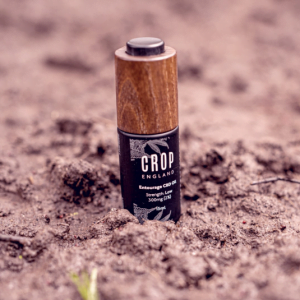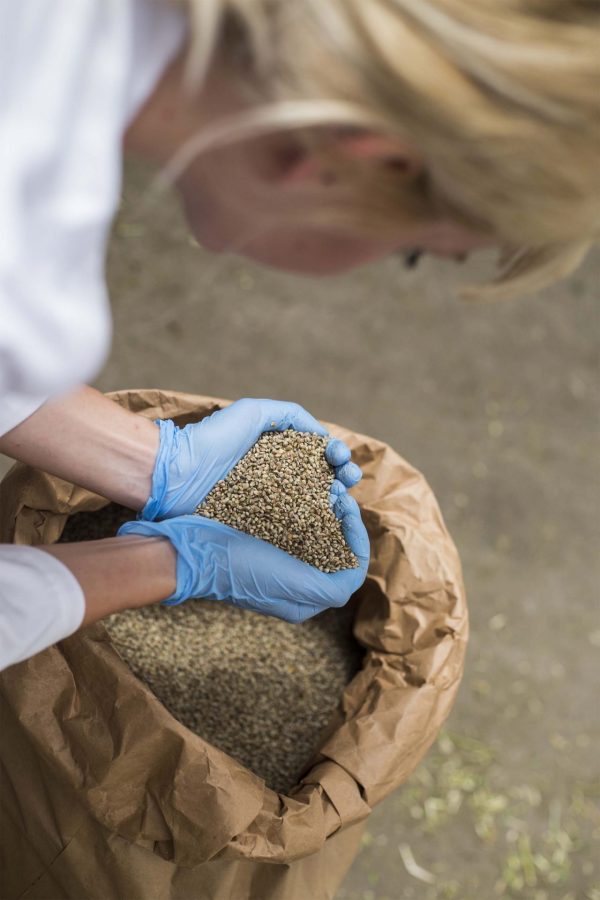1. Selecting the right hemp strain
CBD, or cannabidiol, is a chemical compound extracted from the hemp strain of the Cannabis Sativa L. plant that partners with the body’s endocannabinoid system. When choosing a hemp strain, we look for varieties high in CBD and low in THC (or tetrahydrocannabinol). The latter is the psychoactive compound and a legally controlled substance in the UK that creates the intoxicating “high” of cannabis.
2. Seeding & planting hemp
We start by using seeds from Finola, a Finnish varietal of the hemp plant. This is a certified organic seed that’s not genetically modified or treated with any chemicals and provides fast-growing and incredibly durable hemp.

Bioaccumulation & hemp
Hemp is known as a bioaccumulator (meaning it absorbs whatever chemicals are in the soil). Concentrations of heavy metals and other nasty chemicals can be soaked up by the hemp plant – it’s even used in radioactive sites to clear the soil of contaminants, but as you can probably guess, this contaminates the plant.
This is where a sustainable hemp company really stands out against the crowd. Unlike many farms, we don’t use any pesticides or chemical fertilisers, just good old fashioned manure from traceable cattle and chicken farms. This means our hemp coexists with the natural goodness of the soil, creating superior quality oil. For more on hemp – check out our expansive article here.
The environmental benefits of hemp
One of the vital environmental benefits of hemp is its ability to act as a carbon sink. Carbon in soil is fantastic for soil health and allows for greater water retention (preventing things like flooding and the loss of topsoil). It also helps feed the soil’s microbiome, which is the crucial element for soil health and improved structure.
Just one hectare of industrial hemp can absorb 22 tonnes of CO2 per hectare. In addition, hemp’s rapid growth (growing to four metres in a hundred days) makes it one of the fastest CO2-to-biomass conversion tools available. It’s also widely celebrated for being more efficient than agroforestry and using mature wood as a carbon sink!
If you’re looking for more on the incredible importance of soil, check out our short article on Why Soil Health is Critical for CBD.
3. Harvesting & drying hemp
Industrial hemp is an incredibly fast-growing crop, taking about four months to reach maturity. What’s more, the plant thrives in our UK climate with well-drained soil. We’ve found that the less disturbance to the soil, the better the hemp grows. For this reason, we use tractors with automatically deflatable wheels to soften the tyre tread on the earth and prevent soil compaction.
We use an originally designed destemming and harvesting machine on the field, which helps separate the hemp seeds from the rest of the plant. Once the stock is harvested, the hemp plants are hung upside down and air-dried for four weeks. This is a tricky part of the process, where too much humidity can cause mould and mildew, reducing the quality of the hemp seed oil.
4. Extracting Cannabinoids
The extraction process is how the hemp plant is turned into oil. Various types of solvents can be used to separate cannabinoids, and each impacts the quality of your CBD.
What methods are used to extract CBD?
CO2
CO2 extraction uses carbon dioxide to produce a highly concentrated oil when the gas is put under high pressures in a low-temperature environment. This process transforms the gas into a liquid and passes it through the harvested cannabinoids and terpenes, resulting in the purest oil possible.

Ethanol
Ethanol is a type of alcohol used for extraction. As a polar solvent, it mixes with water to draw out water-soluble molecules and fatty cannabinoid compounds. The resulting dark liquid is a mixture of cannabis compounds and chlorophyll, which is filtered out. One issue with this filtration step is that it can exclude some of the cannabinoids, thus lowering the overall purity of the CBD oil.
Hydrocarbon
Hydrocarbon extraction uses solvents such as propane or butane to extract CBD oil. Although this is a cheaper and more straightforward process, the resulting oil is often inefficient and contains a higher concentration of the illegal compound THC and a lower strength of CBD.
What is the best way of extracting CBD?
Both ethanol and CO2 extraction methods can produce highly effective cannabidiol. However, the inefficiencies of the Hydrocarbon approach have meant this isn’t really used in the UK CBD industry anymore. The possibilities for residue and contamination are much higher, so it’s unlikely to make it through a CBD company’s quality control measures.

5. Purifying & winterising CBD
Purification, or winterisation, is an optional step that removes excess plant materials to improve CBD concentration in food-grade ethanol. As you might expect from the name, winterisation involves cooling the mixture to -20 degrees Celsius. As the plant fats and waxes are less soluble at this temperature, they can be filtered out while leaving the cannabinoids in the mixture. Once separated, the alcohol is then evaporated from the purified CBD liquid.
6. Processing & Heating CBD
Decarboxylation involves heating the ingredients to separate the carbon atom from the cannabinoids. Removing this molecule activates the compounds and increases their bioavailability, meaning that more of the active CBD is available to be used by your body. Like any recipe, it’s critical to heat the liquid at a precise temperature and time. Too much and the CBD oil is overcooked, and the compound is broken down and lost. Too little, and the bioavailability is reduced.
7. Mixing & infusing CBD oil
Entourage CBD oils
To craft a CBD oil that offers superior levels of bioavailability with all the terpenes and cannabinoids, we carefully select a range of cannabis strains that work together in the oil. This combination increases what is known as the ‘The Entourage Effect,’ a concept conceived by Raphael Mechoulam, the man who first discovered THC and CBD who suggested that cannabis compounds such as CBD work better when taken together.
CBD Carrier oils
We mix the concentrated CBD entourage oil with a carrier oil. This acts as the delivery system for the CBD to your body, boosting bioavailability and ensuring you get the greatest benefits from the cannabinoids and terpenes.
We use a cold-pressed hemp seed oil that is legally grown on our farm. You’ve likely seen the reports that hemp seed oil is a superfood celebrated for its high concentration of plant proteins, vitamins and minerals. It’s rich in omega-3 and 6 and, while less studied than olive oil for its health benefits, it has also been shown to have a unique nutritional profile of its own.

8. Bottling CBD
When it comes to bottling CBD oil, the most important thing is to protect the liquid against exposure to light, heat, and air. Each of these forces can cause the breakdown of natural cannabinoids like CBD.
We use an opaque bottle which blocks 100% of the sun’s rays. This means that your product is completely protected from harmful UV light that causes premature degradation. We use glass as the inner vial as plastic can react with the CBD, which again can cause a breakdown of cannabinoids.
9. Testing CBD products
While the CBD oil industry is regulated, it’s still in its early stages of reaching a level where you can be assured of pure and high-quality CBD. You’ve likely heard the reports of contaminants and mislabelling – even where CBD products sold by British retailers contain no actual CBD!
This is why third-party testing is essential. These laboratories rigorously test products to identify any potential contaminations and the actual percentages of CBD and THC concentrations within the product. As with ours, you should be able to find these reports on a company’s website. We’ve also written extensively on CBD and the law here.
How to use harvest, process and extraction information to inform your CBD product choice.
Now you have the fundamentals of how CBD is made; you know exactly what’s critical to quality when purchasing your CBD oil. When reading labels and researching CBD companies, ask yourself these questions:
Is the hemp strain used high in CBD and low in THC?
- Is the hemp strain used high in CBD and low in THC?
- Where is the hemp harvested?
- How is the CBD extracted?
- What carrier oil is used in the CBD oil?
- Is the CBD oil third-party approved?
Final Word
Hopefully, this post has ironed out any questions you have around how CBD oil is made, including the various methods available and their impact on product quality. As the year progresses, we’ll be adding more videos and images so you can see exactly how we farm hemp and grow such a potent and powerful CBD oil.
So, where are you on your CBD journey? If you’re just beginning, we’d recommend checking out our CBD Starter Kits. If you’re experienced with cannabinoids, we think you’ll love our Medium and High Strength oils. Why not find one that’s right for you today.

